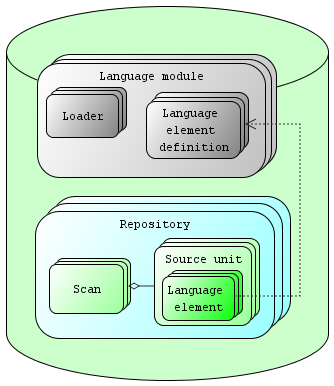Mesopotamia glossary
| Description | Glossary of Mesopotamia terms |
| Id | 128 |
| Last modified | Wed Aug 08 00:11:39 EDT 2007 |
| GUID | 4e1956dabcdacc3b07321336ce77eb45483875ba |
 |
| Figure 1. Mesopotamia architecture. |
Glossary
Class
L
Language element
Language element is a unit of parsing (e.g. variable definition).
Term 267Source unit typically consists of a tree of language elements. Language elements can reference other language elements (e.g. variable reference can reference variable definition) and also they reference
Language element defintion. A language element can reference language elements defined in other languages. For example, EJB deployment descriptor XML element can refernce EJB Java class language elements. This feature is very important for code reviews of nowadays software systems where very often Java (or some other language) code is glued together with XML configuration files, HTML or XML file contain JavaScript scriptlets, etc.
References
Language element definition
Definition of a language element. It contains information needed for parsing and also language element documentation, which helps to quickly learn the language.
Language element defintion
Language module
Language module is a component to parse sources written is a particular language, e.g. Java. Language module contains
Term 272Language element definitions and
Term 273Loaders. Language modules delivered as Java libraries which contain .jar files, configuration files to load definitions to the database, and documentation.
References
Loader
Loaders are components to progressively parse source data into a network of
Term 269Language elements. Loaders are organized into an acyclical graph where one loader works on results of work of other loaders. E.g. parser loader depends on lexer loader.
References
R
Repository
Repository is collection of
Term 267Source units. Repository corresponds to a directory of source files.
S
Scan
Scan represents
Term 274Repository state at a given point of time. Scan contains one or more
Term 267Source units. One
Term 267Source unit can belong to multiple scans if it has not been changed between scans. Mesopotamia loads sources incrementally, which is important for codebases with thousands of source units (files).
References
Source unit
Unit of source code, e.g. file. Source unit represents state of a file at a given point of time (scan time). So it corresponds to a revision of a file in SCM terms. Source unit can have successor, predecessor and it can belong to multiple
Term 268Scans.
References
Referenced by
Glossaries referencing this glossary
